 |
| Charmion, a controversial trapeze artist who did an aerial striptease from conventional Victorian streetwear to a leotard. She appeared this month at the Gayety. |
By
Samuel L. Leiter
For comprehensive background on Brooklyn’s pre-20th-century
theatre history please see my book, Brooklyn Takes the
Stage: Nineteenth-Century Theater in the City of Churches (McFarland: 2024) and my
blog, “Annals of the Brooklyn
Stage.” The latter is a week by week description of theatre
activity in Brooklyn; obviously, it will expand rather slowly because so much
must be described and the present blog will be occupying my attention until
live theatre in Brooklyn begins to fade over the early decades of the 20th century,
dying out by the 1930s.
The entries in this blog began as annual ones, for 1898 and
1899. Because of the large amount of memory used, which made editing them
problematic, subsequent entries were shortened so they covered only several
months at a time, but these too needed to be shortened. Thus, beginning
with 1901: September, all entries cover a single month. The quickest way
to find any of these entries is probably to click on the following link, where
links to everything prior to its date are provided: 1901: DECEMBER
For 1902 click here.
For 1903 see below:
January 1903 welcomed a solid number
of starring actors, although none in plays that were especially groundbreaking.
Least familiar locally was Bertha Galland, whose career flamed out at the end
of the decade, arrived as Esmeralda in a version of Hugo’s The Hunchback of
Notre Dame whose title left only the cathedral’s name intact. Others stars were
better known locally, among them Chauncey Olcott, William Faversham, Amelia Bingham,
Mary Mannering, James K. Hackett, and Denman Thompson, the latter in his
perennial meal ticket, The Old Homestead, beloved as an icon of the
rural drama.
The borough’s restless theatrical evolution
saw one of its five stock companies, Blaney’s, return to the old-time convention
of hiring visiting actors to join the resident company in plays featuring their
starring qualities. Blaney’s began with several weeks in which Melbourne
McDowell and Florence Stone showed off their repertory. At the same time, Blaney’s
Theatre reverted to the best known of its previous names, the Novelty. More
significant yet was the opening on January 19, 1903, of a second stock company
managed by Corse Payton and his wife, Etta Reed Payton, a development promised
in an earlier entry of this blog. Mr. Payton, so successful at his Lee Avenue
Theatre in the Eastern District, had purchased the former Criterion Theatre on
Fulton Street in the Western District as a gift for Mrs. Reed, whose project it
became both offstage and on.
Hamilton Ormsbee of the Eagle
was concerned this month with asserting the value of stage design in both sets
and lighting, which he considered a boon to old plays, like Shakespeare’s that
relied more on the audience’s imagination than on scenic investiture. While
unwilling to see the visual element become, as it now often was, the most important
aspect of theatregoing, he appreciated Mark Twain’s insistence that Shakespeare
should be produced with all the advantages of modern lighting, which was
progressing by leaps and bounds, as recently represented by E.H. Sothern’s Hamlet,
not yet seen in Brooklyn, or by Richard Mansfield’s ostentatious Julius
Caesar, which would arrive several months later. Believing the stage appealed
first to the eye and then to the ear, he feared the actor’s elocutionary art
would die if spectacle became too dominant. Thus, he insisted that “the
perfection of stage art is the union of the two in just the right proportion.”
Such aesthetic concerns, however, took
a back seat in editorial columns to the ongoing struggle to compete against the
Theatrical Syndicate, especially as represented in 1903 by the Independent
Booking Agency (IBA), run by Maurice Campbell and Harrison Grey Fiske,
Henrietta Crosman’s manager. When Crosman recently played Brooklyn, it was at the
non-syndicate Brooklyn Academy of Music. However, James K. Hackett, another pillar
of the IBA, played his January engagement at the syndicate’s Montauk Theatre
because when he joined the IBA he was still contracted to the syndicate, an
obligation that would end after the current season. Something similar affected
his wife, Mary Mannering, who had starred at the Montauk a week earlier. With
no word yet on her plans, Hamilton hoped she would join the IBA if only to prevent
the spouses from being on opposite sides in the war. All of which was to note rumors
that the independents might obtain a Brooklyn theatre of their own soon so they
could better compete against the syndicate, or trust. Word of the independents’
fall plans were awaited, not only locally but nationwide. Hamilton believed an
independent Brooklyn theatre competing in the Western District with the Montauk
would raise the quality of the shows engaged. If Brooklynites confined their
theatregoing to their borough, he thought, there were enough of them to support
four high-priced theatres.
The anti-syndicate people insisted
that the six men who ran the syndicate reaped most of the profits, leaving the
local managements and the companies that played there only the scraps. Speaking out, however, could endanger one’s
career with so much power held by the syndicate. Before they could succeed, the
independents needed to control enough theatres to offer traveling actors and
productions 30 weeks of work, in return for which they would not take any
profits, thus luring many defectors to their side. It was, however, impossible
to predict just how many stars and combinations would abandon the trust.
What made the trust so powerful was
its control of the booking agency, a system that allowed a company to schedule
its entire season in a day, rather than by the old method of correspondence
with each theatre. The agency was run by Klaw and Erlanger with an iron grip.
Their partners were Frohman, Hayman, Nixon, and Zimmerman. Many complications
were involved, of course, and there was friction within this cabal because
several of them had competing interests as managers themselves.
Hamilton’s article, in the January 11,
1903, Eagle goes more deeply into the weeds on how the syndicate made
its money, and what accommodations it was willing to make, than I wish to
discuss here, but it makes clear that the syndicate was holding back actors and
producers (managers) from getting themselves or their products seen easily,
thus prompting Crosman, Mrs. Fiske, and Hackett to band together in the
Independent Booking Agency.
The difference between them and the
trust: “The independents make no charge, not even a percentage, either to the
theaters or to the combinations for which they find engagements. The three managers
pay the expenses of their agency out of their own pockets.” In other words,
they were more altruist than capitalist. Crosman and Fiske suffered mightily in
their bookings as a result, but they may have hoped for increased profits down
the line if they succeeded. The promised announcement of the IBA’s plans would
keep Brooklyn eyes on the lookout, promised Hamilton.
1.
January 5-10, 1903
Amphion: Notre Dame, with Bertha Galland
Bijou: (Spooner Stock Company) Mam’zelle
Blaney’s: (Blaney’s All-Star Stock Company) The Factory
Girl (last week of stock company; theatre becomes Novelty Theatre again
from January 12)
Columbia: (Greenwall Stock Company) La Tosca, with
Melbourne McDowell, Florence Stone
Folly: New 8 Bells, with the Byrne Brothers
Gotham: (Gotham Theatre Company) The Three Guardsmen
Grand Opera House: Robert Emmet, with Brandon Tynan
Montauk: The Stubbornness of Geraldine, with Mary
Mannering
Park: The Road to Ruin
Payton’s: (Payton Theatre Company) Northern Lights
Phillips’ Lyceum: (Lyceum Theatre Company) Man’s Enemy
Vaudeville and burlesque: Hyde & Behman’s, Star, Gayety,
Unique, Orpheum
2.
January 12-17, 1903
Amphion: The Mocking Bird, with Mabelle Gilman
Bijou: (Spooner Stock Company) At Old Fort Lookout
Blaney’s: (renamed Novelty Theatre)
Columbia: (Greenwall Stock Company) Giaconda, with Melbourne
McDowell, Florence Stone
Folly: The Prince of Tatters, with Al H. Wilson
Grand Opera House: The Old Homestead, with Denman
Thompson
Gotham: (Gotham Stock Company) On the Wabash
Montauk: The Crisis, with James K. Hackett
Novelty: (previously Blaney’s Theatre; now a combination
house) Nobody’s Claim
Park: A Desperate Chance
Payton’s: (Payton Theatre Company) A Night Off
Phillips’ Lyceum: (Lyceum Theatre Company) Lady Nell
Vaudeville and burlesque: Hyde & Behman’s, Star, Gayety,
Unique, Orpheum
3.
January 19-24, 1903
Amphion: A Modern Magdalen, with Amelia Bingham and
company
Bijou: (Spooner Stock Company) The Thoroughbred
Columbia: (Greenwall Stock Company) The Empress Theodora,
with Melbourne McDowell, Florence Stone
Folly: The Volunteer Organization
Gotham: (Gotham Stock Company) The Lost Paradise
Grand Opera House: Lost River
Montauk: The Cardinal, The Middleman, All
for Her, David Garrick, Tom Pinch, with E.S. Willard
Novelty: Looping the Loop, with Alphonse and Gaston
Park: A Gambler’s Daughter
Payton’s Lee Avenue: (Payton Lee Avenue Stock Company) Under Two Flags
Payton’s Fulton Street: (Payton Fulton Street Stock Company), A
Royal Family, with Etta Reed Payton (at the former Criterion Theatre)
Phillips’ Lyceum: (Lyceum Theatre Company) The Musketeers
Vaudeville and burlesque: Hyde & Behman’s, Star, Gayety,
Unique, Orpheum
4.
January 26-January 31, 1903
Amphion: Mrs. Jack, with Alice Fischer
Bijou: (Spooner Stock Company) The Buckeye
Columbia: (Greenwall Stock Company) Fedora, with
Malcolm McDowell, Florence Stone
Folly: Robert Emmet, with Brandon Tynan
Gotham: (Gotham Stock Company) Held by the Enemy
Grand Opera House: Old Limerick Town, with Chauncey
Olcott
Montauk: Imprudence, with William Faversham
Novelty: The Little Church Around the Corner
Park: The Scout’s Revenge
Payton’s Fulton Street: (Payton Fulton Street Stock Company) The Planter's Wife, with Etta Payton Reed
Payton’s Lee Avenue: (Payton Lee Avenue Stock Company) A Gold Mine, with Corse Payton
Phillips’ Lyceum: (Lyceum Theatre Company) The Diamond Breaker
Vaudeville and burlesque: Hyde & Behman’s, Star, Gayety,
Unique, Orpheum


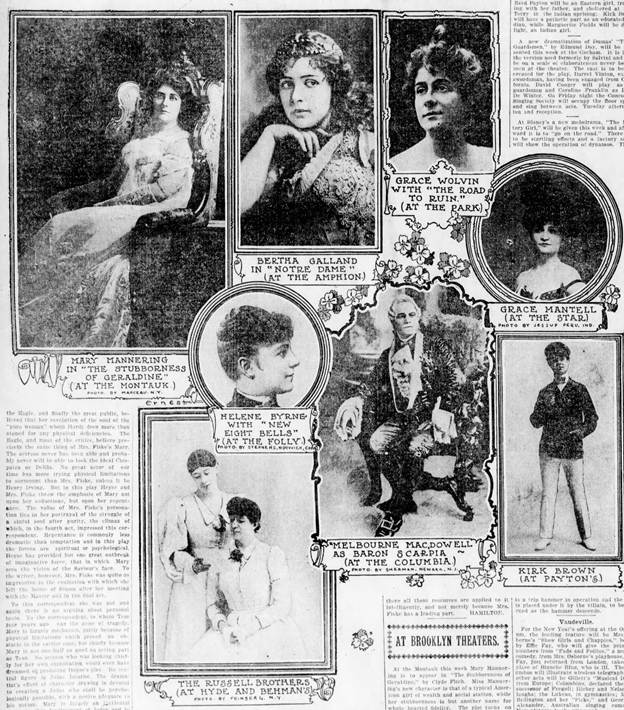
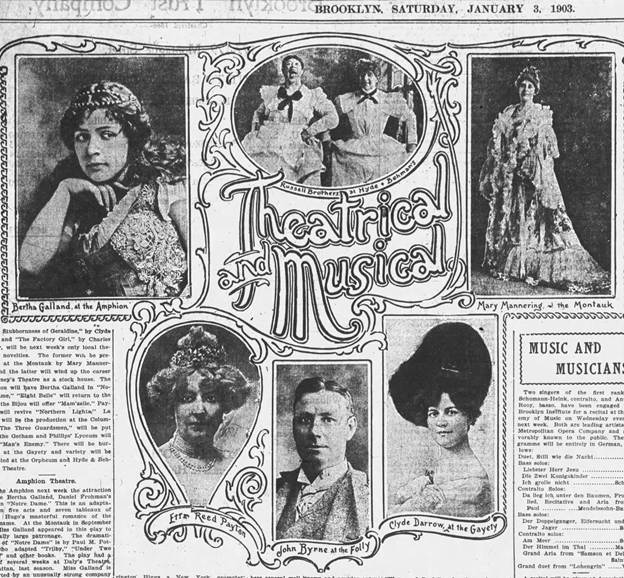


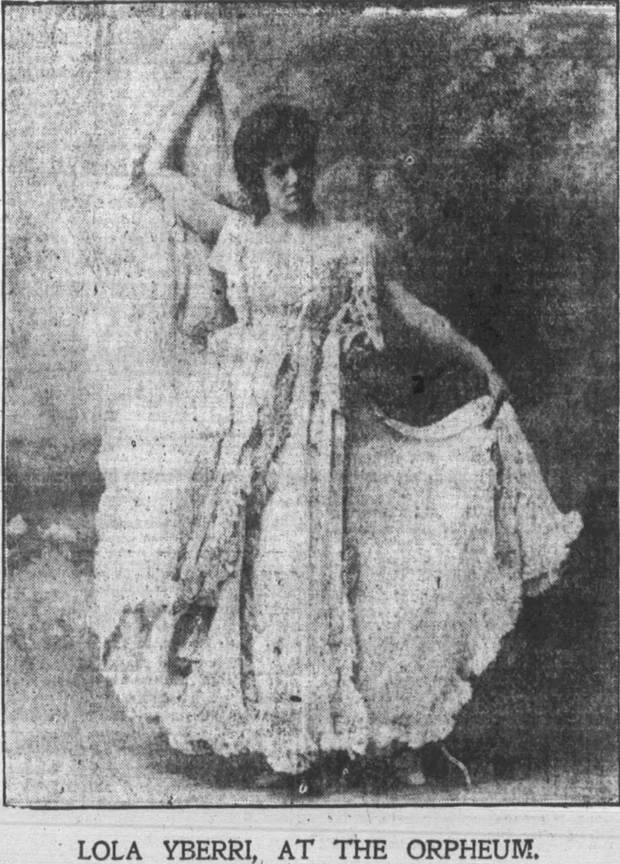

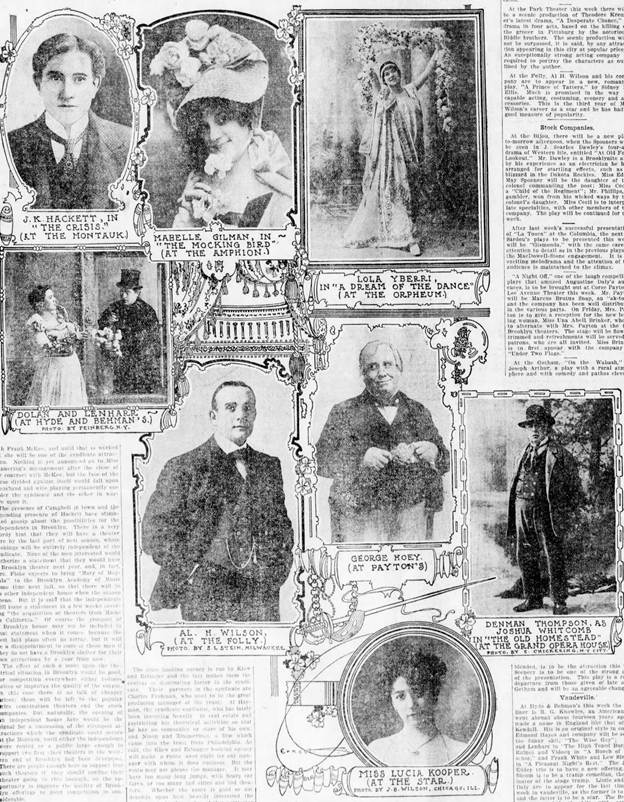



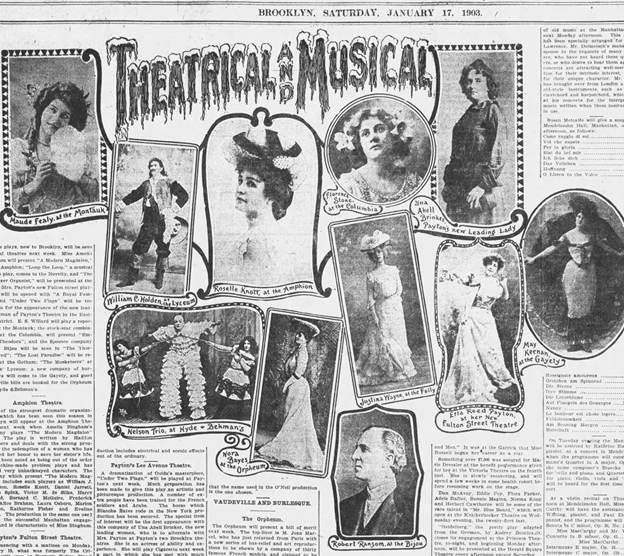

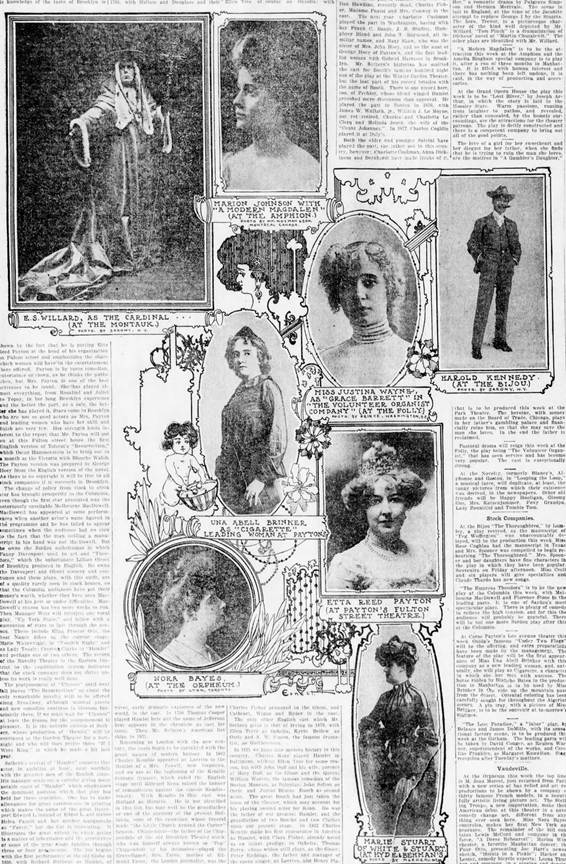
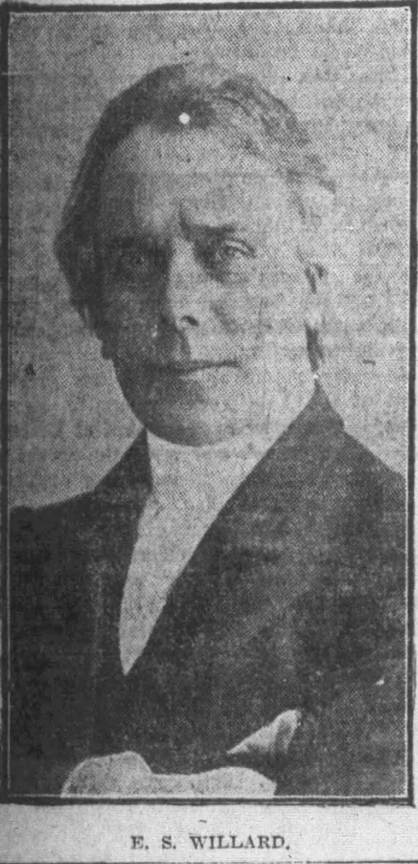
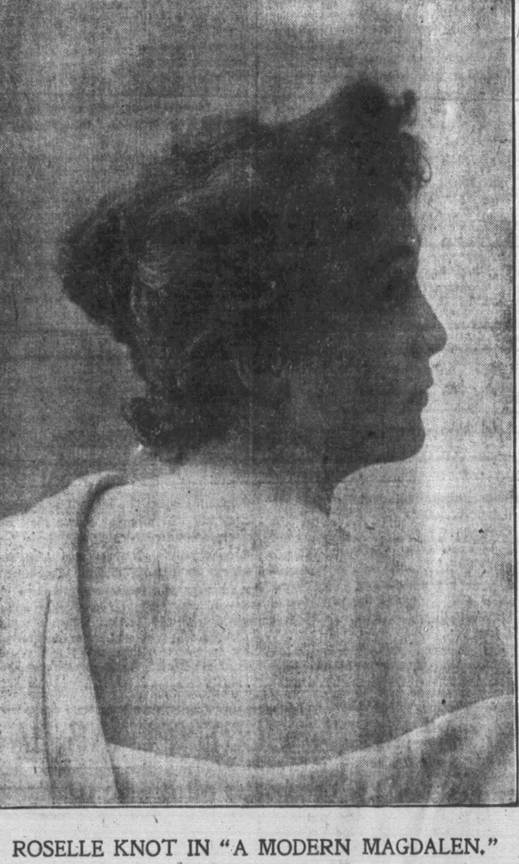





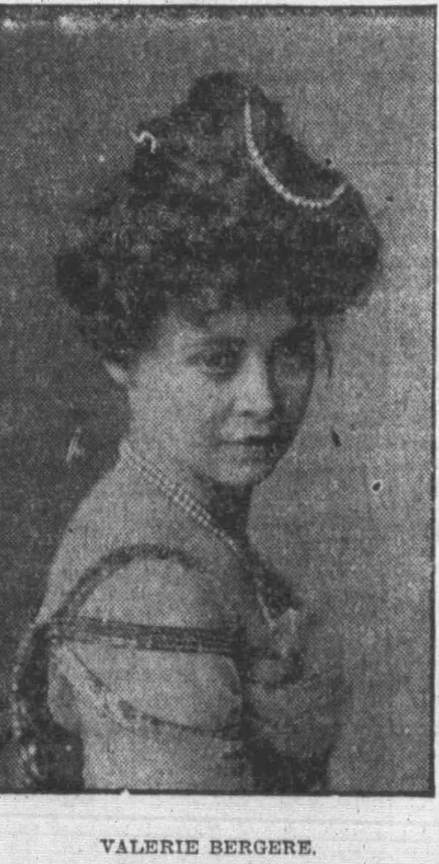




No comments:
Post a Comment